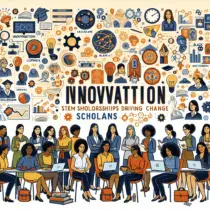In today’s digital age, education has transcended the boundaries of traditional classrooms and moved into the realm of online platforms. As more students opt for online degree programs due to their flexibility and accessibility, the question of financing these programs has become increasingly pertinent. Scholarships specifically tailored for online degree programs are available, and this comprehensive guide aims to shed light on how students can avail themselves of these opportunities.
Understanding Online Degree Programs
Online degree programs offer a flexible alternative to traditional, on-campus education. They allow students to attend classes, complete coursework, and earn degrees from accredited institutions through the internet. This mode of learning is especially beneficial for working professionals, parents, or individuals with other commitments that make attending regular classes challenging.
Types of Online Degree Programs
- Undergraduate Degrees: These include associate’s and bachelor’s degrees in various fields like business, healthcare, technology, etc.
- Graduate Degrees: Master’s degrees and doctorates that provide advanced knowledge and skills in specific areas.
- Certificate Programs: Short-term courses that offer specialized training in various subjects.
The Need for Scholarships
Despite the convenience and flexibility offered by online degree programs, they can still be financially demanding. Tuition fees, study materials, technology requirements (like computers and software), and other expenses can add up significantly. Scholarships play a crucial role in making education accessible by providing financial aid that does not need to be repaid.
Types of Scholarships Available
Merit-Based Scholarships
Merit-based scholarships are awarded based on academic achievements, extracurricular activities, leadership qualities, or other talents. These scholarships do not consider financial need but focus solely on the student’s achievements.
Need-Based Scholarships
Need-based scholarships are designed for students who demonstrate financial need. Factors like family income, number of dependents in the household, and overall financial situation are taken into account when awarding these scholarships.
Program-Specific Scholarships
Certain scholarships are tied to specific degree programs or fields of study. For instance:
- STEM Scholarships: Cater to students pursuing degrees in science, technology, engineering, and mathematics.
- Nursing Scholarships: Focus on supporting students aiming for careers in healthcare.
- Business Scholarships: Assist those enrolled in business administration or related courses.
Demographic-Based Scholarships
These scholarships target specific groups based on factors such as ethnicity, gender, age group (e.g., non-traditional older students), military background (veterans or active-duty personnel), etc.
Institutional Scholarships
Some universities offer exclusive scholarships to their online students. These institutions often have funds set aside specifically for aiding their distance learners.
How to Find Scholarships for Online Degree Programs
Finding suitable scholarships requires diligent research but is well worth the effort given the potential financial benefits.
College Financial Aid Offices
Many universities have dedicated financial aid offices that provide information on available scholarships. Students enrolled in online programs should reach out to these offices to inquire about scholarship opportunities specifically available for them.
Scholarship Databases
Several websites compile extensive databases of scholarship opportunities:
These platforms allow users to search based on various criteria like field of study, demographics, and more.
Professional Associations
Many professional associations offer scholarships related to their field:
- American Psychological Association (APA)
- National Society of Professional Engineers (NSPE)
- American Marketing Association Foundation (AMAF)
Enrolling as student members can sometimes increase eligibility for these awards.
Employers & Community Organizations
Employers may offer tuition assistance or reimbursement programs; some even provide direct scholarship funds if employees pursue further education related to their jobs. Local community organizations, charities, and foundations also frequently support educational endeavors through grants and scholarships.
Application Process
Applying successfully involves several steps:
- Identify Eligibility Requirements: Ensure you meet all criteria before investing time applying.
- Gather Necessary Documents: This typically includes transcripts, recommendation letters, personal statements/essays proving why you deserve this scholarship.
- Prepare Strong Personal Statements/Essays: Tailor essays/personal statements around each specific opportunity highlighting strengths/achievements relevantly.
- Submit Applications Timely: Never miss deadlines; timely submission reflects positively ensuring no disqualification due to lateness while competing rigorously against others!
Tips for Success
To maximize chances of securing desired funding:
- Start Early: Begin searching and applying early since many have fixed deadlines.
- Apply Widely: Don’t limit yourself to just one or two; apply to multiple scholarships to increase your likelihood of winning some.
- Follow Instructions Carefully: Ensure every application is complete and accurate, following the provided guidelines strictly to avoid errors that could cause disqualification.
- Highlight Uniqueness: Distinguish yourself by emphasizing unique attributes that make you stand out amidst the pool of other applicants.
Conclusion
Pursuing an online degree opens doors to myriad opportunities both personally and professionally; however, associated costs can pose significant hurdles. Fortunately, numerous scholarship options exist catering to diverse needs, enabling the dream of obtaining a quality education without insurmountable debt. By strategically identifying and applying for suitable scholarships diligently, the potential to reduce overall costs substantially makes the journey smoother and more fulfilling, ultimately achieving esteemed educational goals.
Start early, stay organized, apply widely, and maintain a positive attitude. Leverage available support systems and follow the tips provided to maximize your chances of securing the financial aid needed to pursue your online degree successfully. Good luck!






